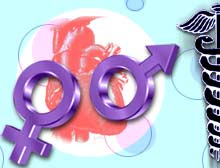|
|
 |
Men's Health>>
S.T.Ds (Sexually Transmitted Diseases) |
 |
 |
 |
 |
S.T.Ds
Introduction to sexually transmitted diseases |
|
|
What are sexually transmitted diseases?
Sexually transmitted diseases (STDs) are diseases that can spread from one person to another by sexual contact. STDs
can cause pain, and some can cause infertility and even
death if not treated. Some common curable STDs are
gonorrhea, trichomoniasis, chlamydial infection, syphilis
and HIV/AIDS.
spread from one person to another by sexual contact. STDs
can cause pain, and some can cause infertility and even
death if not treated. Some common curable STDs are
gonorrhea, trichomoniasis, chlamydial infection, syphilis
and HIV/AIDS.
Each year there are more than 333 million new cases of
curable STDs, one million new cases of HIV infection, and
millions of other viral STDs such as herpes and hepatitis
B. |
|
|
How can sexually transmitted diseases be
contracted?
By definition STDís are diseases contracted during sexual
contact. It isimportant to keep in mind that sexual
contacts, as far as STDs are concerned, includes more than
just sexual intercourse (vaginal and anal). Kissing,
oral-genital contact, and the use of sexual "toys," such
as vibrators too can cause STDs. |
|
|
What can be done to prevent STDs?
People can avoid STDs by changing their sexual behavior.
They can follow any of the ABCs: |
|
|
a. Abstain from sex -This is the only
guaranteed protection.
b. Be mutually faithful -Always have sex
with the same person. This person must not have sex with
any other person and must not have a STD.
Important: You cannot usually tell
whether a person has a STD just by looking at him or her.
People with STDs, including HIV, usually do not look sick.
c. Consistently use condoms -Use them
every time and use them correctly. To prevent STDs, people
at risk should use condoms even when they use another
family planning method. If a womanís sex partner is not
willing to use condoms, she should try to use spermicide.
It is important to note that spermicides do not stop
HIV/AIDS. The diaphragm and cervical cap may also help
prevent some STDs. |
|
|
Are all STDís treatable?
Most STDs are treatable. However, even the once easily
cured gonorrhea has become resistant to many of the older
traditional antibiotics. Other STDs, such as herpes, AIDS,
and genital warts, all of which are caused by viruses,
have no cure. Some of these infections are very
uncomfortable, while others can be deadly. |
|
|
|
Getting Treated
Many STDs can be treated and cured, especially in their
early stages. Some, such as HIV and herpes, cannot be
cured, but sometimes their effects can be stopped for a
time.
Prevention is better than cure especially since
sometimes scarring or infertility can follow.
A person who thinks he or she may have STD should:
|
|
|
- Get diagnosed and treated immediately.
- Take all of the medicine according to instructions,
even if the symptoms go away. The medicines can cause
some side effects, such as vomiting, diarrohea, or rash.
If any of these side effects occurs and is severe, the
person must return to the clinic that provided the
medicine. All of the medicine must be taken for a
lasting cure.
- Avoid sex with anyone until three days after the
treatment is finished and all symptoms are gone.
- Tell his or her sex partner or partners so that they
get treated too. Unless all sex partners are treated at
the same time, they may infect each other again and
again. It is especially important for a man to tell a
woman. This is because many women do not have symptoms
until the STD has reached a more serious stage.
|
|
|
|
If friends have symptoms, urge them to seek care. Urge
them to use condoms and/or spermicide and to see a health
care provider for a check up. There really is no such
thing as "safe" sex. The only truly safe sex is
abstinence. Sex in the context of a monogamous
relationship wherein neither party is infected with a STD
is also considered "safe". Most people think that kissing
is a safe activity. Unfortunately, syphilis, herpes, and
other diseases can be contracted through this relatively
simple and apparently harmless act. All other forms of
sexual contact carry some risk. Condoms are commonly
thought to protect against STDs. Condoms are useful in
preventing certain diseases, such as herpes and gonorrhea.
However, they do not fully protect against other diseases
such as genital warts, syphilis and AIDS. |
|
|
|
|
|
Disclaimer - The contents of this site are
for informational purposes only. Always seek the
advice of a qualified physician for any doubts. |
| | | |


